Designer Fashion Couture Running Shoes 2013
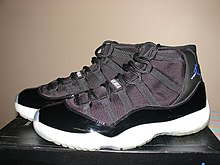

A pair of traditional low-cut Antipodal sneakers
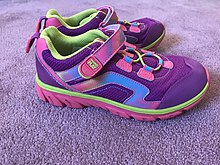
Sneakers (also called trainers, athletic shoes, tennis shoes, gym shoes, kicks, sport shoes, flats, running shoes, or runners) are shoes primarily designed for sports or other forms of concrete practise, but which are now besides widely used for everyday casual wearable.
Since their popularization by companies such as Converse, Nike and Spalding in the mid 20th century, they have become attire, with variety growing in many global markets exponentially. Like other parts of the global clothing manufacture, manufacture of shoes is heavily concentrated in Asia with nine in ten shoes produced in that region.[1]
Contemporary sneakers are largely made from synthetic materials, and the materials and manufacturing process produce, on average, about 14 kg (31 lb) of COtwo emissions.[2] [three] Some companies are trying to substitute more sustainable materials in their industry.[three] Virtually ninety% of shoes cease up in landfills at terminate of life.[four]
Names and etymology
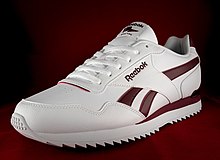
Reebok Royal Glide Ripple Clip men'southward shoe
The shoes have gone by a diversity of names, depending on geography and changing over the decades. The term "sneakers" is about usually used in Northeastern U.s.a., Fundamental and S Florida,[5] [vi] New Zealand, and parts of Canada. However, in Australian, Canadian, and Scottish English language, running shoes and runners are synonymous terms used to refer to sneakers; with the latter term too used in Hiberno-English language. Tennis shoes is another term used in Australian, and Northward American English language.
The British English equivalent of sneaker in its modern class is divided into ii separate types - predominantly outdoor and stylish trainers, training shoes or quality 'basketball game shoes' and in contrast cheap safety-soled, low cut and sail-topped 'plimsolls'. In Geordie English language, sneakers may too be chosen sandshoes, gym boots, or joggers;[seven] while plimsolls may exist referred to as daps in Welsh English language.
Several terms for sneakers be in Due south Africa, including gym shoes, tennies, sports shoes, sneaks, and takkies.[viii] Other names for sneakers includes rubber shoes in Philippine English, track shoes in Singapore English language, sail shoes in Nigerian English, Camboo in Ghana English meaning Military camp kicking and sportex in Greece.
Plimsolls (British English) are "low-tech" able-bodied shoes and are likewise called "sneakers" in American English language. The give-and-take "sneaker" is ofttimes attributed to American Henry Nelson McKinney, who was an advertising agent for N. W. Ayer & Son. In 1917, he used the term because the safe sole made the shoe'southward wearer stealthy. The word was already in use at to the lowest degree every bit early every bit 1887, when the Boston Journal made reference to "sneakers" as "the name boys give to tennis shoes." The proper noun "sneakers" originally referred to how tranquillity the rubber soles were on the footing, in dissimilarity to noisy standard hard leather sole dress shoes. Someone wearing sneakers could "sneak upward", while someone wearing standards could not.[9]
Earlier, the name "sneaks" had been used by prison house inmates to refer to warders because of the safety-soled shoes they wore.[ten]
History

Keds Champion sneaker, for women, 1916
These shoes acquired the nickname 'plimsoll' in the 1870s, derived according to Nicholette Jones' book The Plimsoll Awareness, from the colored horizontal band joining the upper to the sole, which resembled the Plimsoll line on a ship'south hull. Alternatively, just like the Plimsoll line on a send, if h2o got above the line of the safety sole, the wearer would go wet.[11]
Plimsolls were widely worn by vacationers and also began to exist worn by sportsmen on the tennis and croquet courts for their condolement. Special soles with engraved patterns to increase the surface grip of the shoe were adult, and these were ordered in bulk for the use of the British Ground forces. Athletic shoes were increasingly used for leisure and outdoor activities at the plow of the 20th century - plimsolls were even found with the ill-fated Scott Antarctic expedition of 1911. Plimsolls were unremarkably worn by pupils in schools' concrete education lessons in the UK from the 1950s until the early on 1970s.[ commendation needed ]
British company J.W. Foster and Sons designed and produced the first shoes designed for running in 1895; the shoes were spiked to allow for greater traction and speed. The company sold its high-quality handmade running shoes to athletes around the world, eventually receiving a contract for the manufacture of running shoes for the British team in the 1924 Summer Olympics. Harold Abrahams and Eric Liddell won the 100 1000 and 400 m events, kitted out with Foster's running gear.[12]
This manner of footwear as well became prominent in America at the plow of the 20th century, where they were chosen 'sneakers'. In 1892, the U.S. Condom Visitor introduced the showtime rubber-soled shoes in the country, sparking a surge in demand and product. The first basketball game shoes were designed by Spalding as early every bit 1907.[ commendation needed ] The market for sneakers grew later on World War I, when sports and athletics increasingly became a way to demonstrate moral fiber and patriotism. The U.S. market for sneakers grew steadily equally young boys lined upward to buy sneakers endorsed by football role player Jim Thorpe and Antipodal All Stars endorsed by basketball game player Chuck Taylor.
During the interwar period, athletic shoes began to be marketed for different sports, and differentiated designs were made bachelor for men. Athletic shoes were used by competing athletes at the Olympics, helping to popularise athletic shoes among the general public. In 1936, a French brand, Spring Court,[13] marketed the kickoff canvas tennis shoe featuring signature 8 ventilation channels on a vulcanised natural rubber sole.
Adolf "Adi" Dassler began producing his own sports shoes in his mother's wash kitchen in Herzogenaurach, Bavaria, afterwards his return from Globe War I, and went on to establish one of the leading able-bodied shoe manufacturers, Adidas.[14] He also successfully marketed his shoes to athletes at the 1936 Summer Olympics, which helped cement his adept reputation. Business boomed and the Dasslers were selling 200,000 pairs of shoes each twelvemonth before World State of war II.[15] [16]
Mail service-State of war

A large pile of able-bodied shoes for sale at a marketplace in Hong Kong
During the 1950s, leisure opportunities profoundly expanded, and children and adolescents began to clothing sneakers as school dress codes relaxed. Sneaker sales rose so high, they began to adversely affect the sales of conventional leather shoes, leading to a tearing advertising war for market share in the late '50s. In the 1970s, jogging for exercise became increasingly popular, and trainers designed specifically for condolement while jogging sold well. Companies besides started to target some of their products at the coincidental way market. Soon, shoes were available for football game, jogging, basketball, running, etc. Many sports had their relevant shoe, made possible by podiatrist development of athletic shoe technology.
During the 1990s, shoe companies perfected their mode and marketing skills. Sports endorsements with famous athletes grew larger, and marketing budgets went through the roof. Sneakers became a manner statement and were marketed every bit a definition of identity and personality rather than simply athletic aids.[17]
From 1970 (5 models), to 1998 (285 models), to 2012 (iii,371), the number of sport shoe models in the U.S. has grown exponentially.[18]
Use in sports
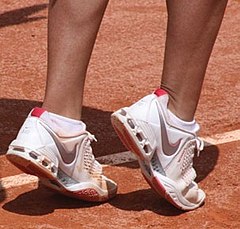
A pair of modern Nike all-purpose athletic shoes
The term 'able-bodied shoes' is typically used for shoes utilized for jogging or road running and indoor sports such as basketball, but tends to exclude shoes for sports played on grass such every bit association football and rugby football, which are generally known in North America as "cleats" and in British English language every bit "boots" or "studs".
Attributes of an athletic shoe include a flexible sole, appropriate tread for the function, and ability to absorb bear upon. As the manufacture and designs have expanded, the term "athletic shoes" is based more on the blueprint of the bottom of the shoe than the aesthetics of the top of the shoe. Today'south designs include sandals, Mary Janes, and even elevated styles suitable for running, dancing, and jumping.
The shoes themselves are fabricated of flexible compounds, typically featuring a sole made of dumbo condom. While the original pattern was basic, manufacturers take since tailored able-bodied shoes for their specific purposes. An case of this is the spiked shoe developed for track running. Some of these shoes are made up to unusually large sizes for athletes with large feet.
Running shoes
Running shoes come in a range of shapes suited to different running styles/abilities. More often than not, they are divided by running style: the majority are for heel-toe joggers/runners which are farther subdivided into 'neutral', 'overpronation' and 'underpronation'.[nineteen] [twenty] These are constructed with a complex construction of "prophylactic" with plastic/metallic stiffeners to restrict foot move. More avant-garde runners tend to vesture flatter and flexible shoes, which allow them to run more quickly with greater comfort.
According to the NPD Group, 1 in iv pairs of running shoes that were sold in the United States in 2016 were bought from an online retailer.[21]
Notable brands
As of 2020[update], brands with global popularity include:
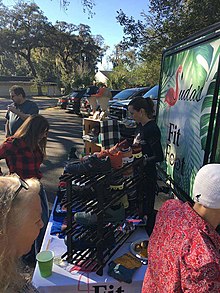
- 361°
- Adidas
- Allbirds
- Anta
- ASICS
- Babolat
- Brooks
- Converse
- DC
- Diadora
- Dunlop
- Ethletic
- Feiyue
- Fila
- Hoka 1 Ane
- Hummel
- Hurley International
- Kappa
- Karhu
- K-Swiss
- Keds
- Li-Ning
- Lotto
- Merrell
- Mizuno
- New Residuum
- Nike
- On
- Onitsuka Tiger
- PF Flyers
- Pony
- Pro-Keds
- Puma
- Reebok
- Salomon
- Saucony
- Skechers
- Stride Rite
- Tisza Cipő
- Umbro
- Under Armour
- Vans
- World Balance
- Xtep
- Supra
Types and number of models
- High-tops cover the talocrural joint.
- Low-tops or oxfords do non comprehend the ankle.
- Mid-cut sneakers are in-between loftier-tops and low-tops.
- Sneaker boots extend to the calf.
- Skid-ons like low-tops/oxfords practise not encompass the talocrural joint and practice not take laces.
- Low-superlative CVO (Circular Vamp Oxford) like low-tops do not encompass the ankle but unlike low-tops take a vamp in a round course and typically 4 to five eyelets.
- Loftier-top CVO (Circular Vamp Oxford) like high-tops embrace the ankle and as well have a round vamp.
Culture

Sneakers have been an important role of hip hop (primarily Pumas, Nike, and Adidas) and rock 'n roll (Converse, Vans) cultures since the 1970s. Hip hop artists sign million dollar deals with major brands such equally Nike, Adidas, or Puma to promote their shoes.[22] [ commendation needed ] Sneaker collectors, chosen "sneakerheads", regard sneakers every bit stylish items. Sneaker companies encourage this trend by producing rare sneakers in limited numbers, ofttimes at very high retail prices. Artistically-modified sneakers can sell for upwards of $k at exclusive establishments similar Saks Fifth Artery.[23] In 2005, a documentary, Just for Kicks, about the sneaker phenomenon and history was released.[24] [ citation needed ]
See also
- Biodegradable athletic footwear
- Comparison of orthotics
- List of shoe styles
References
- ^ Footwear, World. "Global Footwear Industry: Positive Dynamics in 2018". World Footwear . Retrieved 2020-07-30 .
- ^ Cheah, Lynette; Ciceri, Natalia Duque; Olivetti, Elsa; Matsumura, Seiko; Forterre, Dai; Roth, Richard; Kirchain, Randolph (2013-04-01). "Manufacturing-focused emissions reductions in footwear production". Journal of Cleaner Production. 44: 18–29. doi:ten.1016/j.jclepro.2012.11.037. hdl:1721.1/102070. ISSN 0959-6526.
- ^ a b "Are Eco-Runners The Next 'It' Trainer?". British Vogue. 21 October 2019. Retrieved 2021-02-19 .
- ^ Hoskins, Tansy E. (2020-03-21). "'Some soles concluding ane,000 years in landfill': the truth almost the sneaker mountain". The Guardian . Retrieved 2021-02-19 .
- ^ Katz, Josh (25 October 2016). Speaking American: How Y'all, Youse, and You Guys Talk: A Visual Guide. Houghton Mifflin Harcourt. pp. 4–5. ISBN978-0544703391 . Retrieved 13 July 2017.
- ^ Hickey, Walter (v June 2013). "22 Maps That Show How Americans Speak English Totally Differently From One Another". Concern Insider . Retrieved 2017-03-09 .
- ^ "Geordie Lexicon". world wide web.englandsnortheast.co.uk . Retrieved 2017-03-09 .
- ^ Pettman, Charles (1913). Africanderisms: A Glossary of S African Colloquial Words and Phrases and of Identify and Other Names. CreateSpace Independent Publishing Platform. p. 491. ISBN1515051226.
- ^ Mental Floss magazine, Sept-Oct 2008
- ^ Robinson, Frederick William (1863). Female life in prison, past a prison house matron. Hurst and Blackett. ISBN9781341245022.
- ^ Susie Dent (2011). How to Talk Like a Local: From Cockney to Geordie. Random House. p. 99. ISBN9781409061953.
- ^ Foster, Rachael. "Foster's Famous Shoes". Bolton Revisited . Retrieved 15 October 2015.
- ^ "Running Shoes for Plantar Fasciitis Men & Women". Your Comfortable Feet. Retrieved xv October 2015.
- ^ Smit, Barbara (2009). Sneaker Wars. New York: Harper Perennial. ISBN978-0-06-124658-6.
- ^ "Exploring the History of Basketball Shoes". Sports Domain Lab. 18 March 2019.
- ^ "How Adidas and PUMA were born". in.rediff.com. viii Nov 2005. Retrieved 26 September 2010.
- ^ Pribut, Stephen M. "A Sneaker Odyssey". Dr. Stephen M. Pribut's Sport Pages. 2002. Web. 23 June 2010.
- ^ Aichner, T. and Coletti, P. 2013. "Customers' online shopping preferences in mass customization". Journal of Straight, Data and Digital Marketing Practise, 15(ane): xx-35.
- ^ "Empathize pronation to get the correct running shoes". Comfort Hacks . Retrieved 14 October 2015.
- ^ Marius Bakken. "Fitting Your Running Shoes to Your Feet". Retrieved 2009-04-24 .
- ^ Chesto, Jon (2017-07-xix). "New City Sports owners plot revival of Boston brand". The Boston World. Archived from the original on 2017-07-21. Retrieved 2017-07-20 .
- ^ Belzer, Jason. "Sneaker Wars: Kanye W Signs Deal with Adidas, Drake with Jordan Make". Forbes . Retrieved 2016-01-28 .
- ^ 2014 Saks 5th Artery catalog
- ^ History of Sneakers http://theidleman.com/history-of-sneakers
External links
-
 Media related to Sneakers (footwear) at Wikimedia Commons
Media related to Sneakers (footwear) at Wikimedia Commons
0 Response to "Designer Fashion Couture Running Shoes 2013"
Post a Comment